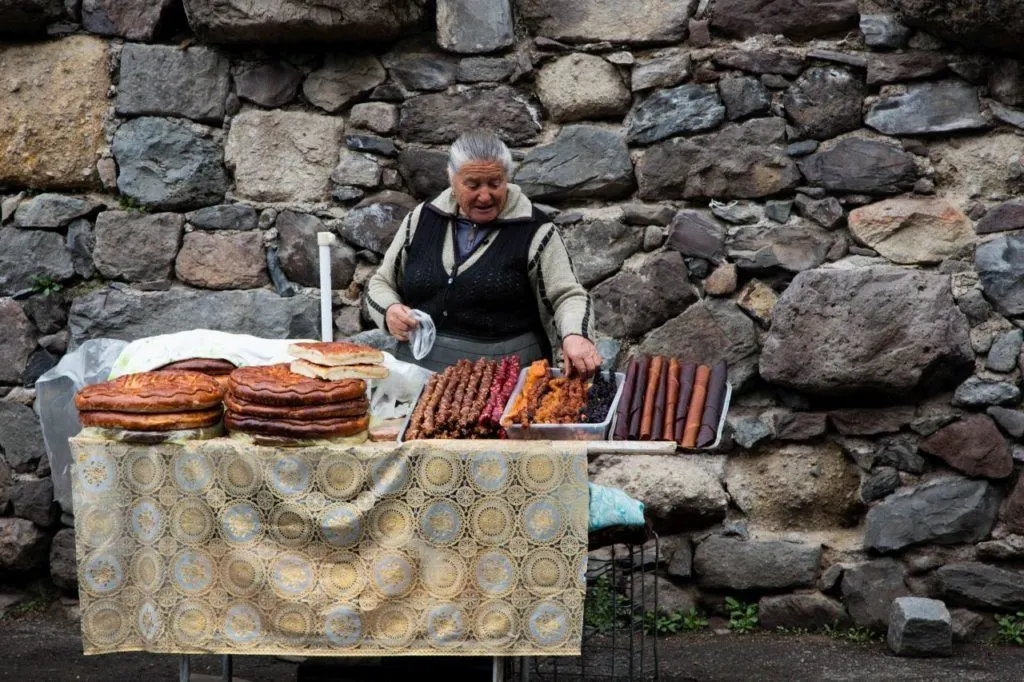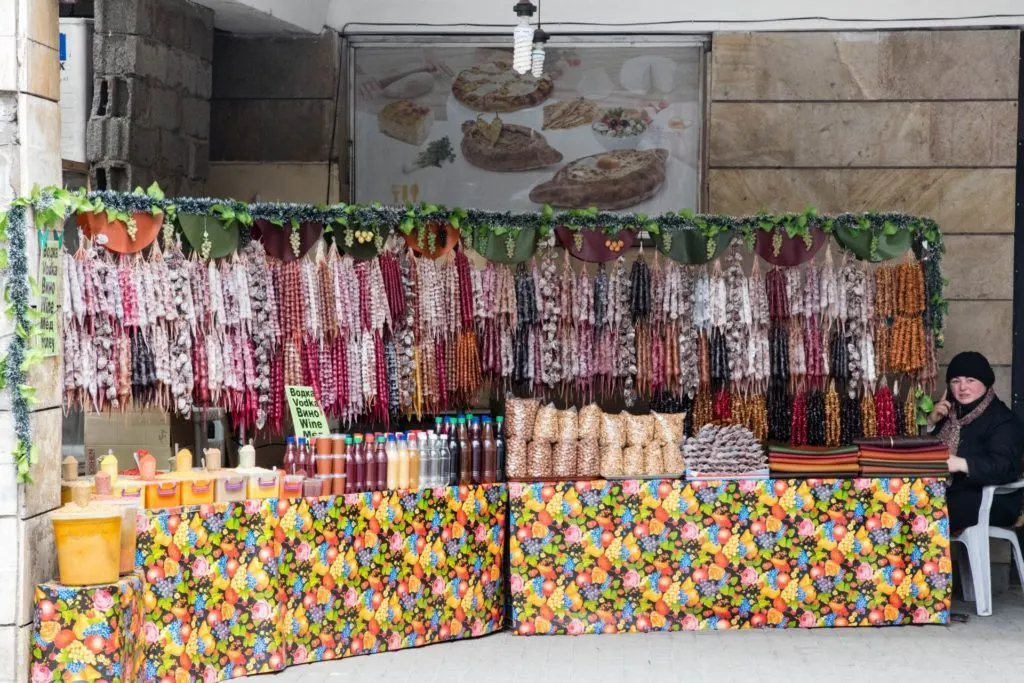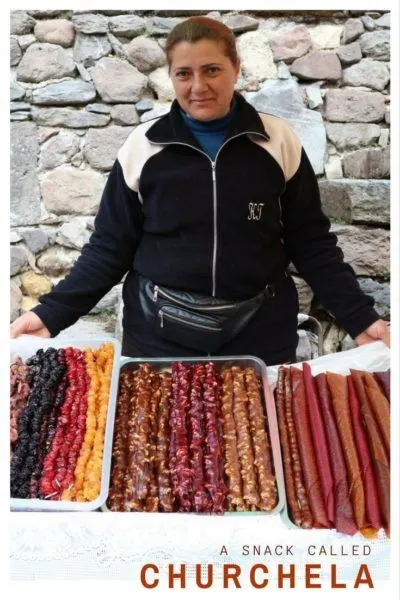Have you tried Churchkhela, a tasty snack found in Georgia, Armenia, and all over Turkey? Warriors brought Churchkhela, the original powerbar, when they went out to the field because it kept them going and going all day long. Read on to find out all about this powerhouse food from the Caucasus as well as how to make it.
Our spring trip to the Caucasus’ wasn’t over, we had plenty of things to do in Georgia and Armenia, and one of them is always learning more about the food in order to fuel our foodie lust.
If you read our recent post on making Georgian dumplings, called Khinkali, then you know that we had to negotiate our way into a restaurant kitchen. The negotiations, made mostly in Georgian by our hotel host, also somehow included making a Georgian snack or dessert, called churchkhela. We couldn’t believe our luck, we considered making the churchkhela a bonus and what a good one it was.

The problem with negotiations is that sometimes the person doing all the talking doesn’t have any idea what this will mean to his workers. The guy we made the deal with was some type of day supervisor who, of course, never goes into the kitchen. Then when we went into the small kitchen to make khinkali.
We had no idea that there was another part of the kitchen, outdoors in the back, where another woman’s job was to make churchkhela. When we showed up she had no idea what we were doing there, but like Marta she soon warmed up to us and gave us one fantastic lesson.
What is Churchkhela?
After living in Turkey for four years, Jim and I had seen the same product hanging all over the country. In Turkey, churchkhela is called cevizli sucuk which means walnut sausage, because it looks like a sausage, and I’ve just recently learned that in Armenian it’s called Sharots. We had tried it a few times and liked it, but it’s not something that we ever really thought about making it.

It’s a good thing that we didn’t eat it much, because as it turns out it has a full day’s worth of calories tucked into one of those little sausages. Warriors used to take it out in the field with them, because it kept them going and going all day long. Today not only is it a popular dessert, but it’s a great food to take hiking or use as a road snack as well.
How to Make Churchkela
Making churchkhela turns out to be rather simple. The hardest part is gathering the traditional ingredients. The jelly is made from wine must, the liquid left over from pressing the wine grapes. The best churchkhela is made in the Kakheti region where so many vineyards are located. Georgians have been making wine in that region for over 8,000 years, oh what great wine it is.

Before starting, the nuts must be strung. We used hazelnuts, but traditionally walnuts are used. Our nuts were already strung and waiting for us. The first thing we did is try the wine must, which according to everyone present is the best part of making wine when you are a child. They loved the must.
It was good and naturally sweet. We were there in spring, but of course the grapes and nuts are usually harvested in fall, so the must lasts as long as it is bottled. If you don’t have must, you can substitute it with about one and half quarts white grape juice and 1/4 cup of sugar.
What is Must?
Must is the juice that is used in making wine, but it’s leftover, and it tastes like a thick, sweet grape juice. Using the must, the liquid should boil down to about half. This doesn’t take as long with must as it is already very thick, but it can take up to three hours with juice and sugar (which you can use if you don’t have a true must).
When reduced to your liking, add one cup of flour little by little to thicken. When the mixture is brown and thick, it is called tatara and it is ready for dipping. To dip the string of nuts, first use your spoon and make a trench. Lay the string down and cover with tatara. Pull up and let the tatara drip off. At this point, it looks just like dipping candles. The churchkhela are done, just hang them to dry.

Before we dipped our churchkhela, our chef teacher scooped out some of the warm tatara and put in some walnuts. It sat on the plate in a circular blob shape. She had us try it and it was pretty good. She told us this is how they served it for dessert, and we did see it offered in some of the restaurants in Tbilisi.
After the churchkhela are dipped, they need to hang a minimum of about 20 minutes, but can last up to three months with no special storage. If you see them hanging on the road side, they look like they have powdered sugar on them, but apparently this is a natural part of the drying process and is just fine. The churchkhela are touted to have many health benefits as well as just being a power food. It is said they are rich in protein, fats, and B vitamin, as well as potassium, so you might want to make a batch the next time you go hiking.

It didn’t take us long to make our churchkhela and to our surprise the workers were setting up a table for us. They served us the local schnapps as well as some pickles and other foods they thought we should try. We all had a good laugh and that was the final end to our Georgian cooking lesson.
Think Churchkhela is your kind of road trip snack?
Author Bio: Corinne Vail is a travel photographer, food lover, and a perpetual traveler who has been travel writing for over 14 years. For many years she lived overseas in Germany, Japan, Turkey, South Korea, and the Netherlands teaching the children of the US. military. She’s visited over 90 countries, and she’s not stopping anytime soon.
Pin Churchkhela for later.


lali
Friday 15th of December 2023
Churchkhela is not Armenian! It is Georgian, which rooted in the Georgian region of Samegrelo! The fact is confirmed even by the etymology of the word.
Emma
Monday 31st of May 2021
In Armenian it's Sharots
Corinne Vail
Tuesday 1st of June 2021
Thank you. I didn't know the name of it in Armenian.
Michael
Sunday 14th of March 2021
Churchkhela has Georgian origins. It’s not an Armenian snack.
Missy
Monday 31st of May 2021
Absolutely Georgian and not Armenian. I’m confused by this story…
Corinne Vail
Monday 15th of March 2021
I definitely had churchkhela in Georgia and Turkey as well. It is found in plenty of places, so it will be easy to find and try.
Vito
Thursday 11th of April 2019
There is just one rule of thumb for churchkhelas - "The fatter, the better".
Jim Vail
Monday 7th of November 2016
Deborah, I don't think it's something I would crave, but it was tastier than I expected.